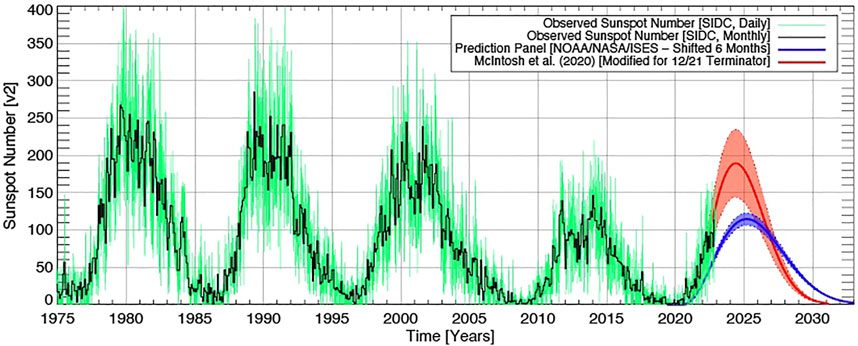The Sun undergoes multiple cycles of activities that are tracked and then used to predict how such activity changes and the impact it might have on Earth. Modeling the Sun is far from easy and the main prediction is now being challenged by a different one: instead of a July 2025 maximum of activity, new work suggests that the maximum will happen in six to 12 months.
The prediction is based on certain magnetic activity of the Sun and uses a particular phenomenon known as the Hale Cycle terminator. The Sun has a 22-year magnetic activity cycle, this is the Hale Cycle. It’s the length of two solar cycles, and it is due to the Sun reversing its magnetic field every 11 years.
Of great importance to the Hale Cycle are the formation of magnetic donuts at 55 degrees of latitude on both hemispheres of the Sun. As the Sun goes through its cycles, these donuts migrate and once they reach the equator, they cancel each other out. These features are terminated.
“In a nutshell, the ‘terminator’ event is the final death throes of those canceling magnetic donuts,” lead author Dr Scott McIntosh, deputy director of the National Center for Atmospheric Research, told IFLScience.
Predicting solar activity is not an easy task. Scientists are using models based on only partial observations of our star’s activity. And currently, solar activity is a lot higher than the consensus prediction had expected. But McIntosh and his team had predicted a lot more action and so far they are being proven right.
In a 2020 paper, researchers stressed the importance of having the terminator event to be able to make a better prediction. And it arrived in December 2021. With that data, the team got working on the new research, which detailed the event and what it might mean for Solar Cycle 25 (SC25).

“This paper basically discusses the signatures of the 12/21 terminator [no different from the others] and, because we anticipated its arrival, we could watch the change in pretty much real-time,” McIntosh explained to IFLScience. “Then we focus on the arrival of the terminator and its impact on the forecast – if the pattern we found in the original work holds then SC25 should look a lot like the historical average.”
“The bonus of the new paper is something we’ve been watching for some time and that’s the ability, post-terminator, to project when the Sun’s magnetic poles reverse – which happens about solar activity maximum. At the time of submission/acceptance we were looking at about 12-18 months to the maximum, we’re now likely under 12 months.”
So far, their model is tracking well with the observations from the Sun. Once the solar maximum is reached, they should be able to start predicting the next cycle, which will begin in the next decade. The good thing about this model is that confirmation that its prediction is correct will come very soon.
The paper is published in Frontiers in Astronomy and Space Sciences.
Source Link: The Current Solar Cycle Might Peak Unexpectedly A Whole Year Early